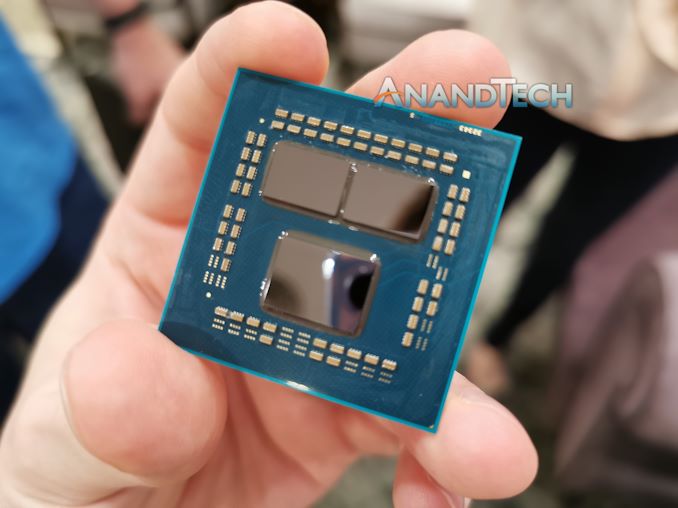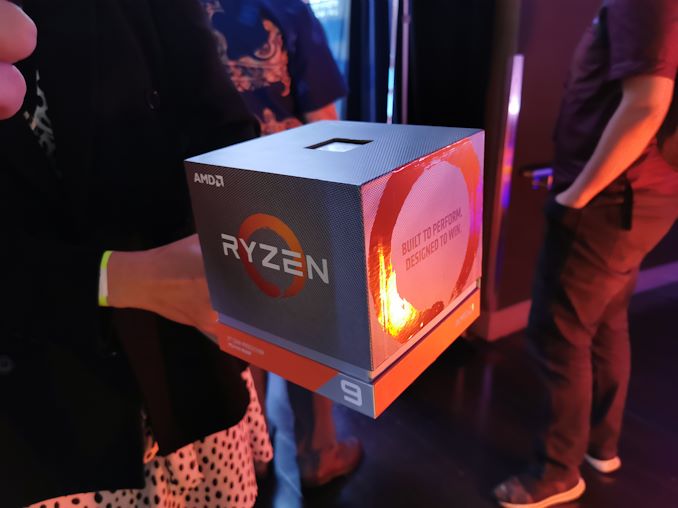AMD 16-Core Ryzen 9 3950X: Up to 4.7 GHz, 105W, Coming September
by Dr. Ian Cutress on June 11, 2019 6:00 PM EST- Posted in
- CPUs
- AMD
- Ryzen
- Zen 2
- Ryzen 3000
- Ryzen 3rd Gen
- Ryzen 9
- 3950X

One of the questions that was left over from AMD’s Computex reveal of the new Ryzen 3000 family was why a 16-core version of the dual-chiplet Matisse design was not announced. Today, AMD is announcing its first 16 core CPU into the Ryzen 9 family. AMD stated that they’re not interested in the back and forth with its competition about slowly moving the leading edge in consumer computing – they want to launch the best they have to offer as soon as possible, and the 16-core is part of that strategy.
The new Ryzen 9 3950X will top the stack of new Zen 2 based AMD consumer processors, and is built for the AM4 socket along with the range of X570 motherboards. It will have 16 cores with simultaneous multi-threading, enabling 32 threads, with a base frequency of 3.5 GHz and a turbo frequency of 4.7 GHz. All of this will be provided in a 105W TDP.
| AMD 'Matisse' Ryzen 3000 Series CPUs | |||||||||||
| AnandTech | Cores Threads |
Base Freq |
Boost Freq |
L2 Cache |
L3 Cache |
PCIe 4.0 |
DDR4 | TDP | Price (SEP) |
||
| Ryzen 9 | 3950X | 16C | 32T | 3.5 | 4.7 | 8 MB | 64 MB | 16+4+4 | ? | 105W | $749 |
| Ryzen 9 | 3900X | 12C | 24T | 3.8 | 4.6 | 6 MB | 64 MB | 16+4+4 | ? | 105W | $499 |
| Ryzen 7 | 3800X | 8C | 16T | 3.9 | 4.5 | 4 MB | 32 MB | 16+4+4 | ? | 105W | $399 |
| Ryzen 7 | 3700X | 8C | 16T | 3.6 | 4.4 | 4 MB | 32 MB | 16+4+4 | ? | 65W | $329 |
| Ryzen 5 | 3600X | 6C | 12T | 3.8 | 4.4 | 3 MB | 32 MB | 16+4+4 | ? | 95W | $249 |
| Ryzen 5 | 3600 | 6C | 12T | 3.6 | 4.2 | 3 MB | 32 MB | 16+4+4 | ? | 65W | $199 |
AMD has said that the processor will be coming in September 2019, about two months after the initial Ryzen 3rd Gen processors, due to extra validation requirements. The chip uses two of the Zen 2 eight-core chiplets, paired with an IO die that provides 24 total PCIe 4.0 lanes. By using the AM4 socket, AMD recommends pairing the Ryzen 9 3950X with one of the new X570 motherboards launched at Computex.
With regards to performance, AMD is promoting it as a clear single-thread and multi-thread improvement over other 16-core products in the market, particularly those from Intel (namely the 7960X).
There are several questions surrounding this new product, such as reasons for the delay between the initial Ryzen 3000 launch to the 3950X launch, the power distribution of the chiplets based on the frequency and how the clocks will respond to the 105W TDP, how the core-to-core communications will work going across chiplets, and how gaming performance might be affected by the latency differences going to the IO die and then moving off to main memory. All these questions are expected to be answered in due course.
Pricing is set to be announced by AMD at its event at E3 today. We’ll be updating this news post when we know the intended pricing.
Update: $749
Related Reading
- AMD Ryzen 3000 Announced: Five CPUs, 12 Cores for $499, Up to 4.6 GHz, PCIe 4.0, Coming 7/7
- AMD Ryzen 3rd Gen 'Matisse' Coming Mid 2019: Eight Core Zen 2 with PCIe 4.0 on Desktop
- AMD: 3rd Gen Ryzen Threadripper in 2019
- AMD Confirms PCIe 4.0 Not Coming to Older Motherboards (X470, X370, B350, A320)
- ASUS Pro WS X570-Ace: A No-Nonsense All-Black Motherboard with x8/x8/x8
- GIGABYTE Unveils X570 Mini-ITX Motherboard: X570 I Aorus Pro WiFi
- ASRock X570 Aqua: Heaviest AMD Flagship Motherboard Ever (Plus Thunderbolt)
- MSI Unveils the MEG X570 Ace: Black and Gold For AMD 50












172 Comments
View All Comments
xrror - Monday, June 10, 2019 - link
I ***really*** hope AMD isn't playing games with that core boost speed. Hopefully that 4.7Ghz speed will be good for at least 2 cores (maybe 1 per core "chiplet") and then the full load/additional cores degradation is graceful enough to give say 4 cores at 4.5, 6 4.4 or something like that.I will be disappointed if that 4.7 is only for 1 core if only since it means that the newer process nodes still suck for scaling.
godrilla - Monday, June 10, 2019 - link
4.7 x 1.15 is 5.405 though.xrror - Monday, June 10, 2019 - link
where do you get the 1.15 mult from? just curiousHul8 - Monday, June 10, 2019 - link
AMD is claiming +15% IPC.Performance = frequency x IPC.
Hul8 - Monday, June 10, 2019 - link
That 4.7 x 1.15 implies that 4.7 GHz on Ryzen 3rd Gen is equivalent to a theoretical frequency of 5.4 GHz on Ryzen 2nd Gen.xrror - Tuesday, June 11, 2019 - link
MEH. Since my main rigs are still socket 1366 xeons, then lets claim (WAG( numbers of +170% Intel generational advantage.But say there, since I run my ancient garbage pre-spector/meltdown Gulftown /
Westmere-EP at 4.4Ghz w/o the remediation patches...
I have no idea where I stand.
But since Intel already disowns me (socket 1366/X58 has no official Windows 10 support) and my system still gets the cold shoulder (the micro-op cache prefech from the early exploits came Sandy Bridge and later, not Westmere) when I migrate those rigs from win8.1 to 10 they will eat that "punishment/hit" even though their arch pre-dates the speculative permission exploits.
I whine, but my niche self is nothing compared to all of the Sandy Bridge systems getting the shaft.
my last two builds were Ryzen 1600 and 1600x
I know that the only reason that AMD's pre-fetcher hasn't been corn-holed as bad as Intel's is due to popularity, but at least I can hope, with AMD being the underdog still, that they'll at least give me a compelling upgrade option sooner than the 10 years I've seen Intel ignore 1366.
zealvix - Monday, June 10, 2019 - link
Or they can do what Intel did with 8700, provide a cooler that is just sufficient for base all cores speed. :Dzealvix - Monday, June 10, 2019 - link
Wrong reply, ignore the abovexrror - Monday, June 10, 2019 - link
Well ironically, AMD did kinda do that for the 1xxx Ryzens. Additional cooling past the stock coolers really didn't give you much more headroom.So maybe there is something to be read into the specs of the OEM cooler. ;)
psychobriggsy - Tuesday, June 11, 2019 - link
That's what I am wondering as well.Previously the turbo clock was for 1 core per CCX. The theory is that each 8C Zen 2 die is still 2 CCXs, so there is a chance that 4.7GHz is a quad-core turbo.
And the maths can be made to work out, assuming AMD isn't playing around with TDP. I will assume that TDP is met both at base clocks and at turbo clocks.
105W - I/O (15W?) / 16 is 5.6W per core, at 3.5GHz
As the clocks increase, so will the per-core power consumption for the faster cores. AMD doesn't use tables like Intel any more though, so there is a kind of smooth scaling thing going on.
It is easy to imagine that at 4.7GHz, a core will use 20-25W of power. So 4 can be at that speed within the TDP.
(However, we don't know the voltage curves for Zen 2 and TSMC 7nm, it could equally easily be 4C Turbo = 4.4GHz, 2C Turbo = 4.6GHz and 1C Turbo = 4.7GHz). I hope reviews do some investigation here, presumably as part of whatever tweaks AMD has done to XFR, etc.